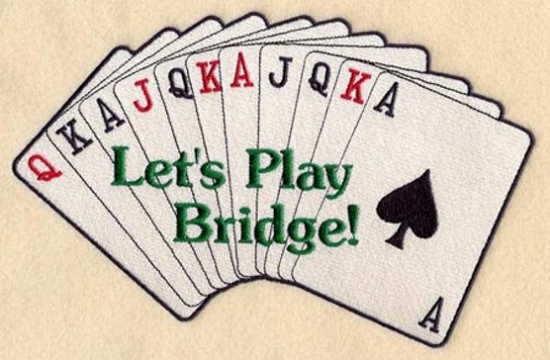
Playing bridge on the Internet, especially in the individual competitions where your partner on a given hand could be anything from a novice to an expert can turn out to be (pardon the expression) a mixed bag of tricks.
Last week I was declarer in 3NT with the South hand:
|
|
North |
|
|
|
♠ J 10 9 |
|
|
|
♥ A K 8 |
|
|
West |
¨ 5 3 |
East |
|
♠ 6 5 3 4 |
§ A Q 10 7 |
♠ K 7 |
|
♥ 7 6 2 |
|
♥ 9 5 4 3 |
|
¨ J 10 9 4 |
South |
¨ A K 8 7 2 |
|
§ 8 6 |
♠ A Q 8 2 |
§ J 9 |
|
|
♥ Q J 10 |
|
|
|
¨ Q 6 |
|
|
|
§ K 5 4 3 2 |
|
OK, game in clubs is cold, but it’s very difficult to avoid the 3NT trap playing top-bottom. Anyway, West led the diamond Knave, East overtook with the ¨K, continued with his Ace, I dropped my Queen and West followed with his lowly ¨4. West won the next two tricks with the ¨10 and ¨9 but the suit was now blocked. There was no way for the defense to reach the last diamond in East’s hand for the setting trick. Of course, West should have played one of his high diamonds under the Ace at trick 2, preserving the ¨4 as an entry to partner’s hand.
We were lucky that West never found the obvious unblocking play but sometimes, as declarer, you have to make your own luck by deploying a blocking play to lock out a suit that the opponents would otherwise be able to run to defeat your contract. Consider the following hand where, once again, you are declarer in 3NT with the South hand. Please note that I have purposely not indicated the full distribution of the opponents’ minor suit holdings.
|
|
North |
|
|
|
♠ K 10 9 |
|
|
|
♥ A K 8 |
|
|
West |
¨ 7 5 3 |
East |
|
♠ 5 3 2 |
§ Q J 10 7 |
♠ 7 6 4 |
|
♥ 7 6 |
|
♥ Q 5 4 3 |
|
¨ J 10 9 6 4 ? |
South |
¨ K Q ? |
|
§ A 8 ? |
♠ A Q J 8 |
§ 9 3 ? ? |
|
|
♥ J 10 9 3 |
|
|
|
¨ A 8 |
|
|
|
§ K 5 4 |
|
West leads the diamond Knave, which you are told indicates he has no higher card in that suit. East plays the ¨Q. What do you do? Your by-now-natural instincts are to duck but this is not the correct play. If East has 3 diamonds, it doesn’t matter if you duck or not: The opponents will drive out your ¨A and will be able to cash their long diamonds when in with the §A to defeat the contract, irrespective of whether West started with 5 or 6 diamonds. It’s a small chance, admittedly, but what if East has ¨KQ doubleton? Winning the first trick with the ¨A will block the suit in East’s hand for, when the opponents win their §A, East will have no choice but to win the diamond continuation with the ¨K with no way to reach his partner’s hand thereafter.
In the actual hand, East’s diamond royal pair was doubleton so your winning the opening lead would have aced the opponents. A word of caution, however: If you had been careless enough to run four rounds of spades before knocking out the §A, East would have been able to discard the blocking ¨K on the fourth round of spades, leaving West with unfettered diamond tricks to sink your contract. This so-called jettison play of East is a valuable weapon in the armory of both defender and declarer and will be the subject of a future article.
Returning to the first hand reminds me of a time when I was sitting East against a 1NT contract. Once again the diamond Knave was led – this time by my expert partner.
|
|
North |
|
|
|
♠ 8 2 |
|
|
|
♥ A K 8 4 |
|
|
West |
¨ 5 3 |
East |
|
♠ A Q 10 7 |
§ A Q 10 7 6 |
♠ J 9 3 |
|
♥ 7 6 2 |
|
♥ Q J 10 3 |
|
¨J 10 9 4 2 |
South |
¨ A K 8 7 |
|
§ 8 |
♠ K 5 6 4 |
§ J 9 |
|
|
♥ 9 5 4 |
|
|
|
¨ Q 6 |
|
|
|
§ K 5 4 3 2 |
|
I won with ¨K and continued with the ¨A, partner playing the ¨10! She won the third diamond trick with the ¨9 and played her lowly ¨4 to my ¨8, blocking the suit in my hand. Expert partner? Oh yes! She had done this on purpose to force me to play the ♠J through declarer. Declarer ducked and my partner unblocked her ♠10 under my Knave, allowing me to repeat the lead another two times. We ended up with 9 tricks and an outright top on the board.
Until next time, avoid blocking your own hands and keep your minds unblocked to all possibilities of helping the opponents block theirs. Play carefully when Knaves enter.
CORRECTION
Apologies. In my previous article, “Safe or Sorry”, ESRA 163, Jan / Feb 2012, the bidding was inadvertently omitted from the second deal, so West’s opening lead and my subsequent analysis didn’t make much sense. The article should have read:
“I was dealer in the South seat and the bidding proceeded as follows:
|
North |
East |
South |
West |
|
|
|
1§. |
Pass |
|
2¨ |
2 ♠ |
2NT |
Pass |
|
3¨ |
Pass |
3NT |
|
West led the ♠J. East could not afford to overtake his partner’s card so played low and I, of course, ducked. West continued with the ♠10, East played low and I again ducked. The contract was now safe. West was now out of spades so couldn’t attack that suit any further. The defense could now only take the ¨A and one other spade. …”
 That Certain Smile
That Certain Smile Fay Shelter 1919-2012
Fay Shelter 1919-2012 Doreen (Devorah) Goldberg 1924 – 2012
Doreen (Devorah) Goldberg 1924 – 2012 Bridge the right way
Bridge the right way A Bit of Humor on Food
A Bit of Humor on Food ESRA Photo enthusiasts meet monthly
ESRA Photo enthusiasts meet monthly Alan Caplan
Alan Caplan